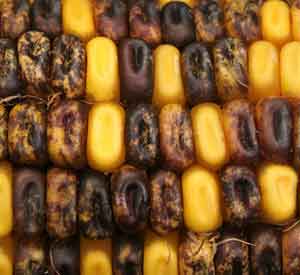My Cart
Your Shopping Cart is currently empty. Use Quick Order or Search to quickly add items to your order!

For many years, Indian corn (Zea mays) has been a model organism that teachers use to explain dominance/recessiveness,
genotypes/phenotypes, and monohybrid/dihybrid inheritance. Typically, the corn phenotypes Carolina offers involve the color
or shape of the kernel. We maintain parental stocks of the following colors: red, white, purple, and yellow. Occasionally,
an ear of corn has kernels that contain spots or streaks of purple or red, instead of being completely solid. This variegated
streaking opens the door to introduce a topic to students that typically does not fit the constraints of the high school curriculum.
Transposable elements (TEs), also known as “jumping genes,” are the source of these streaks or spots.
Initially considered “junk” DNA, transposable elements are now recognized as important components of plant and animal genomes.
Transposable elements make up about 50% of the human genome, while as much as 90% of some plant genomes consist of TEs. In 1948, geneticist
Dr. Barbara McClintock, who would later win a Nobel Prize for her work, discovered that maize transposable elements have the ability to cause a
number of spontaneous mutations. Since then, scientists have discovered that jumping genes provide unexpected diversity to genomes that may be either beneficial or harmful.
These genes hop around from one location to another within a chromosome, inserting themselves into different regions, both changing the DNA
and activating/inactivating the normal functions of nearby genes. Dr. McClintock called these moving genes “controlling genes” because they
controlled the activity of pigment-producing genes.
For example, the gene that codes for purple pigmentation in kernels, which Dr. McClintock named C (for color), is located on chromosome 9. Dr.
McClintock noticed the presence of a DNA sequence (called Ds) on chromosome 9. This DNA sequence has the ability to hop around and break the chromosome, which corresponded to a change in kernel color. If Ds were positioned next to the C gene, the kernels were colorless. In the absence of Ds, the kernels were purple. Therefore, this fragment of DNA demonstrated the ability to keep a gene from doing its job.
Dr. McClintock also noticed the involvement of an activator gene (called Ac) that activated the jumping gene (Ds). In the presence of Ac, Ds will hop out of the position adjacent to C. The dominant pigment-producing gene then expresses again, and regions of pigmented cells become visible.
This results in a spotted appearance on the maize kernel. The size or quantity of the spots/streaks is determined by how long during kernel development
the jumping genes are located next to the color gene. Excision of Ds late in kernel development results in small spots, while early excision results in large spots.
Carolina’s breeding program seeks to eliminate the effects of transposable elements on kernel color. However, don’t be surprised if your students
report that they have found speckled kernels in their corn. Use it as a teachable moment to open a discussion of jumping genes. And point out to
students that any kernel that clearly has at least one speck of purple color should be scored as having the purple phenotype, because it has at least one copy of the purple allele.